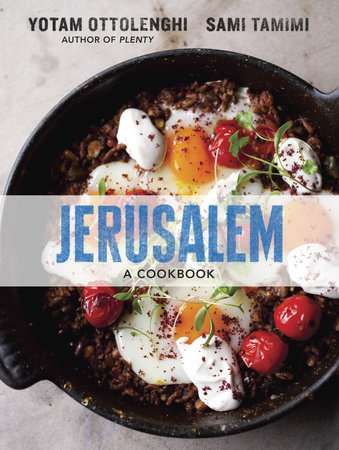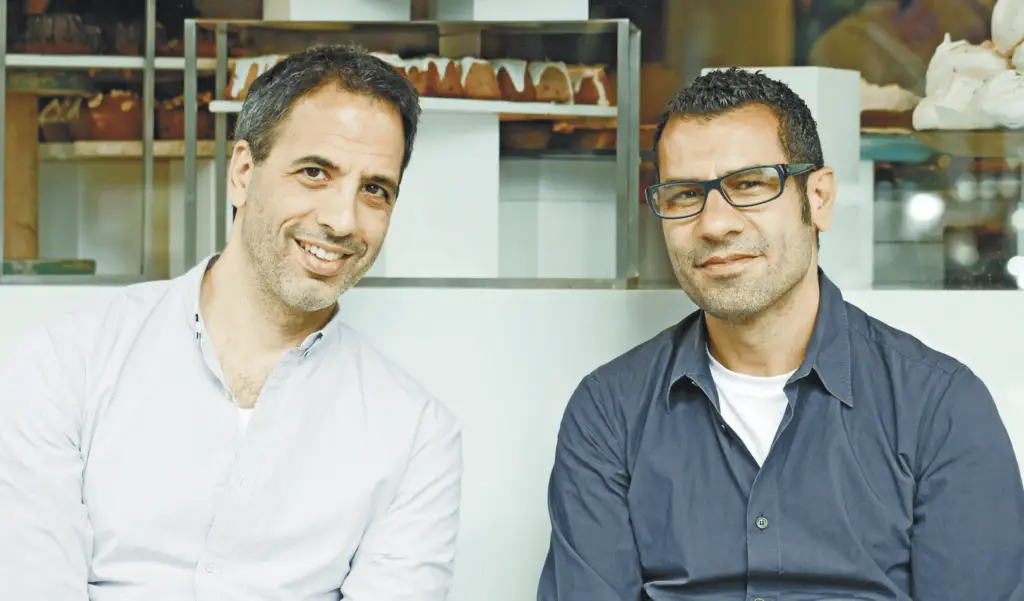Jerusalem: A Cookbook, by Yotam Ottolenghi and Sami Tamimi.
Some cookbooks are defined by a generation. Your grandmother’s shelf likely held The Joy of Cooking or Julia Child’s The French Chef. Your mother’s, The Silver Palate or The Moosewood Cookbook. Jerusalem is a cookbook that has similarly struck a culinary-cultural nerve, tapping into an unbridled interest in global and cross-cultural cuisine. Even if the book isn’t on your shelf, you may well have been served one of its delectable dishes at a dinner party. The large format, full-color 320-page volume (published in 2012 by Ten Speed Press), has a unique across-the-board appeal—how many cookbooks can claim to be listed in the Anthropologie catalog?
The book’s authors grew up on opposite sides of the divided city, and now both live in London—Tamimi in the Arab East, Ottolenghi in the Jewish West. The 120 collected recipes, whose categories range from soups and condiments to meat, fish, and an intriguing category called “Stuffed,” tap into iconic flavors and ingredients of the Near East—lemon, lamb, chickpeas, and eggplant, for example—ingredients whose origins may be humble, but which here take on a Michelin five-star appeal. The book’s design is glorious, not to mention practical (the oversize format has a waterproof cover and lies flat easily). The photographs are full-page, some two pages, and the color and detail are gallery-worthy. In a starred review, Booklist said, “the passion and skill evident in this collection of Mediterranean cuisine are contagious.”
Jerusalem (the city) is historically known for its wide-ranging influences—Christian, Muslim, and Jewish cuisines—that incorporate flavors from across cultures: Iran, Poland, Syria, Italy. Of the book’s intense appeal, The New York Times said:
“Jerusalem seems like an open door to a new realm of flavor. The recipes are full of sun, accented with salt, and rife with crunchy and creamy contrasts. There are new grains, greens, and spices to explore, and fistfuls of garlic, capers, feta cheese, and other familiar ingredients from around the Mediterranean.”
Some cooks may be put off by lists of ingredients, but for the recipes in Jerusalem, it’s likely most are already in your pantry. My first attempt was the “Roasted cauliflower and hazelnut salad,” a gem whose most exotic ingredient was pomegranate seeds—and the sherry vinegar I had to buy. If you think cauliflower doesn’t belong in a salad, you have yet to eat it roasted, a preparation common in Near East cooking. I first ate roasted cauliflower in my Turkish grandmother’s kitchen and can attest to the superior sweet nuttiness achieved by roasting. The addition of toasted hazelnuts, celery, parsley, and spices bring the bright flavors and lively textures typical of Ottolenghi and Tamimi.
As the Times noted, Jerusalem may well be the only cookbook with its own social media hot zone: #tastingjrslm is certified across a number of sites. Though for me, preparing the dishes in this extraordinary book is far more pleasurable than sharing them online.
—Lauren Alwan


